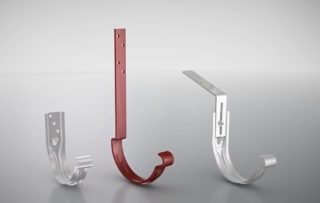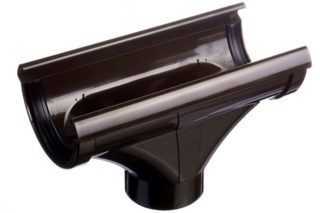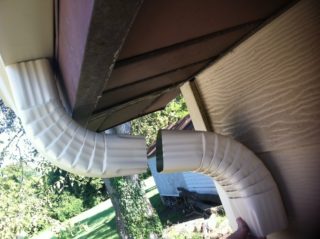For high-quality protection of the building facade and foundation from atmospheric moisture, it is advisable to mount a drainage system. All parts of the drainage system have their own purpose and are assembled in a specific order. It is impossible to install a communication without one of its main elements. Distinguish systems according to the type of material into metal (galvanized steel and copper) and polymer. According to the shape of the section of the drainage pipe, communications are round and rectangular / square. All parts are made in accordance with GOST (dimensions, strength).
Elements of the drainage system

All communication for drainage of storm water consists of the following details:
- bracket for downpipe;
- water intake chute (aka horizontal tray);
- funnel;
- drain pipe;
- clamps for fixing it;
- auxiliary elements for a full-fledged gutter system device: transition elbows, plugs, gutters, etc.
Each of the parts requires adherence to the technique of its installation.
Brackets
The gutter fittings are in the form of hooks. The radius of their bend is equal to the section of the tray. The gutter fits snugly into the curved hook. Due to this, it is securely fixed. There are long and short brackets. The first is mounted to the rafters of the roof frame. The second is to its frontal board.
The brackets must be fixed with an equal pitch of 50-70 cm. The larger the diameter of the gutter and the heavier the material from which it is made, the smaller the distance between adjacent hooks should be.
It is important to observe the slope of the brackets towards the intended funnel. Thus, the water will go into it by gravity. The slope is made at the rate of 0.3-0.5 cm per 1 linear meter of the drainage line. The hooks extreme to the funnel are attached at a distance of 10-15 cm from it. This way the brackets will hold the water receiver.
If the length of the wall of the house exceeds 10 m, you can make a slope both to one end and from the middle to the edges.
Water intake trays

The rainwater drainage channel is a kind of channel into which storm water flows from the roof. The section is semicircular, open. Depending on the area of the slope from which the water will be drained, the tray is selected according to its throughput. If the calculations are wrong, the water will splash over the edge of the small channel. And for a larger one, money will simply be wasted.
The trays are installed in the mounted brackets until they click. Additionally, they are fixed with gutter connectors. When installing channels, move upward from the intake funnel. Thus, each previous tray will form an overlap with the next.
Funnel

The central element of the drainage system. It serves for the correct direction of storm water into the vertical pipe. Funnels are mounted at the lowest point of the line of water intake trays. The norms do not prohibit making this point at the corners of the building or in the center of the facade (if the length of the wall is too long).
There are two types of funnels on the market:
- Flat. Designed for flat roofs.
- Bell-type. Such elements have a receiving grille in the design. It protects the pipe from debris entering the system. Thus, the line is not clogged with leaves, branches, sticks, etc.
The funnel is always installed first, having previously formed a hole in the gutter. Already from it, they begin to lay a water intake line from the remaining trays.
Trumpet

This component also belongs to the main ones. The pipe is only attached vertically to the wall. For installation, use special clamps. Each downpipe holder is positioned in 70-100 cm increments.
It is important that the distance from the pipe to the wall is at least 3 cm. Sometimes it is possible to indent up to 8 cm if the diameter of the element is large enough. Such a technical clearance prevents touching the building gutter at the moment of its vibration when transporting water downward. If you do not follow this recommendation, the pipe will periodically beat against the wall, violating the integrity of the plaster, exposing the facade to condensation.
The end point of the downspout is the sink. It is placed about 25-30 cm from the ground. If this distance is reduced, ice formation in the system is not excluded in winter. It is recommended to drain the drain directly into a gutter.
Other auxiliary elements

The following details help to create a complete set of communication:
- Knee. Designed to bypass architectural elements of a building when installing a downpipe. The knee has the same cross-section as the tuba. The bending angle of the element is 135 degrees.
- Pipe connector. It is used if there is a need to lengthen the vertical section of the system. It is also used when installing knees.
- Clamp. Special fastener for fixing the downpipe to the wall. Attaches directly to the facade. Structurally, it is a ring with a pin. The clamp prevents the pipe from deviating from the vertical.
- Gutter plug. Installed at the end points of the horizontal inlet to prevent water splashing over the edge. There are universal plugs, left-handed and right-handed. Elements are round and rectangular. It is important to choose exactly the one that will fully fit the purchased trays.
- Tee. Structurally, it is a small piece of drainpipe that has several branches. A tee is used if it is necessary to dilute a vertical tube.
- Protective grill. An auxiliary element that protects the system from blockages. The grids are installed both on trays and on a funnel. As a result, leaves, branches, pebbles and other debris do not clog the canals.
- Adjustable angle. Designed to complete the horizontal section of communication in case the angle of rotation of the roof is not equal to 90 degrees. With an adjustable angle, you can bypass the configuration of any bay window.
All additional parts for a complete drainage system are sold per piece.
Prices for elements of the drainage system
In the Moscow region, the following prices have been set for system elements:
| Item type | Material | Price (rub / piece) |
| Bracket for trays | Cink Steel Polymer | 94 147 |
| Gutter | Galvanized steel Polymer | 185 242 |
| Corner tray 90 degrees | Cink Steel Polymer | 314 454 |
| Downpipe | Cink Steel Polymer | 400 571 |
| Self-tapping clamp | Cink Steel Polymer | 71 106 |
| Pipe elbow | Cink Steel polymer | 132 171 |
| Funnel | Cink Steel Polymer | 264 372 |
| Tray connector | Cink Steel Polymer | 95 150 |
| Plug | Cink Steel Polymer | 71 106 |
The Russian-made Aquasystem copper drainage system has an order of magnitude greater cost. For example, one tray will cost 6,615 rubles / piece; funnel - 1,175 rubles; drain pipe (size 1 m) - 2,295 rubles; gutter connector - from 730 rubles.
A reliably and correctly assembled drainage system made of any material will serve for a long time and efficiently.








